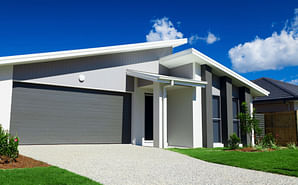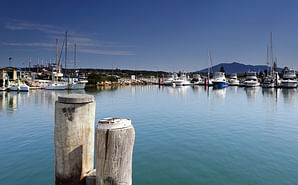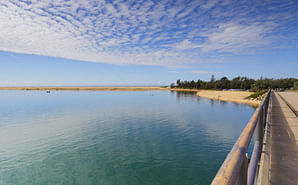Sewerage infrastructure
Sewerage infrastructure in the Bega Valley Shire and what it consists of.
The Sewerage infrastructure network in the Bega Valley Shire consists of:
- 276 kms of gravity sewer mains
- 140 kms of sewer rising mains
- 59 sewer pump stations
- 990 pressure sewer pump stations (pods)
- 6628 manholes
- 10 sewage treatment plants (STPs)
- 4 effluent reuse systems owned by Council, 11 in total
- 11 effluent disposal systems
The diameter of sewer mains depends on the number of properties served. The minimum diameter is 150mm. Sewer mains are made of a variety of materials including polyethylene (PE), unplasticized polyvinyl chloride (uPVC), vitrified clay (VC), asbestos cement (AC), cast iron (CI), ductile iron (DI) and concrete.
The diameter of the low pressure sewer mains ranges from 40 mm up to 225 mm. Pipe material is high density polyethylene (HDPE). Other features of low pressure sewerage systems include isolation valves, flushing points, air release valves and check and stop valves at the junction of each property connection with the pressure sewer main.
Strategic objectives for sewerage assets
Sewerage assets are operated and maintained to:
- Maintain public health levels
- Minimise environmental impacts
- Meet defined levels of service
- Provide cost-effective, efficient and reliable sewerage services
Sewerage assets and levels of service
Levels of service for sewerage assets include:
Design parameters:
- Average dry weather flow (ADWF) = 0.011 L/s/tenement
- Peak dry weather flow (PDWF): as per formula in Council’s Development Specifications
- Peak wet weather flow (PWWF): as per formula in Council’s Development Specifications
Frequency of system failures:
- Category one: failure due to rainfall and deficient capacity = 0
- Category two: failure due to pump or other breakdown including power failure = 1 in 5 years, 0 for critical locations
- Category three: failure due to blockages, chokes and collapse <30 per 100 km of sewer main per year
Response time to system failures:
- Sewer system main breaks and chokes: 30 minutes
- Pressure sewer pump units and controls: 8 hours
- Telemetry repeater station: maximum 24 hours interruption to paging system
Asset condition and serviceability
Assets are continually assessed for condition and serviceability. Condition assessment involves consideration of the material, asset age and identification of defects and deterioration. Serviceability assessment involves consideration of hydraulic performance, energy efficiency, frequency of maintenance and repair, break history, complaints and performance in comparison with levels of service.
Asset renewal and new asset programs are based on condition and serviceability assessments.
Assets we own
The replacement value of sewerage assets is estimated at $230 million. The average annual operation and maintenance expenditure required for sewerage assets is estimated at 2.3% p.a. or $5.29 million. This relatively high annual capital expenditure is to maintain a high standard of asset condition and ensure a reliable service and positive environmental outcomes.
More information on renewal expenditure can be found in the following documents:
- Sewerage Systems Asset Management Plan
- Development Servicing Plan for Sewerage
- Strategic Business Plan for Water Supply and Sewerage Services
Asset maintenance
Routine maintenance is regular on-going work that is necessary to keep sewerage assets operating. Maintenance includes:
- Reactive maintenance (unplanned): to correct malfunctions and failures as required and respond to service and management requests. eg. clearing blockages, repairing main breaks and pump failures.
- Proactive maintenance (planned): works to prevent infrastructure failure carried out to a pre-determined schedule. eg. monitoring computer telemetry (pump hours, pump starts, alarms), inspecting civil infrastructure, testing faults and operation of pumps and generators, washing down pumps, checking impeller clearances, cleaning pump wells, inspecting sewer mains with closed circuit camera television equipment (CCTV), high pressure jetting of sewer mains, calibration of monitoring equipment, cleaning sediment from effluent storage ponds and aeration tanks.
- Cyclic maintenance (recurring): replacement of lower value components/sub components on a regular cycle. eg. replacing oil and water seals, lubricating bearings and motors, replacing gaskets, changing batteries.
Council’s Water and Sewerage Services Area Field Teams and Technical Services Team implement reactive, proactive and cyclic sewerage asset maintenance under the supervision of the Water and Sewerage Network Operations Superintendent and the Water and Sewerage Operations Coordinator.
Maintenance Work Reports are completed by the field teams after maintenance works are undertaken. The Maintenance Work Reports are provided to the Water and Sewerage Services Management Team to update Council’s AssetPlan asset management system for scheduling investigations and capital upgrades.
Asset renewals
Asset renewals are capital works to restore, rehabilitate, replace or renew water supply assets to their original service potential. Renewals do not increase the design capacity of the assets. Sewerage system renewals include:
- Sewer main replacement – eg. renewal of cracked or dropped pipes.
- Pump station renewals – eg. renewal of pumps, switchgear, controls.
- Sewage treatment plant renewals – eg. renewal of screens, blowers, aerators, pumps, switchgear, controls.
New assets
New assets are required to improve existing assets beyond their capacity and/or to provide a higher level of service. This occurs as a result of growth, social or environmental needs and/or changes to statutory requirements or regulations.
Over the next 5 years we will be building a deep water ocean outfall at Merimbula to replace the existing beach face outfall and also upgrades to Merimbula STP to improve effluent quality. An ocean outfall was selected by a community and stakeholder focus group as the best effluent disposal option based on environmental, economic and social criteria.






Was this helpful?